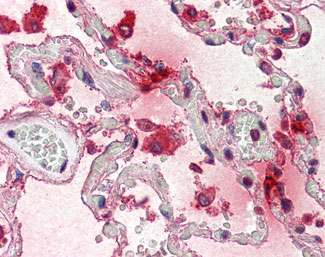TPSAB1 / Mast Cell Tryptase Antibody
Mouse Monoclonal Antibody
- SPECIFICATION
- CITATIONS
- PROTOCOLS
- BACKGROUND

Application
| WB, IHC-P, E, IHC-F |
|---|---|
| Primary Accession | Q15661 |
| Reactivity | Human, Monkey, Dog, Cat |
| Host | Mouse |
| Clonality | Monoclonal |
| Calculated MW | 31kDa |
| Dilution | IHC-P (5 µg/ml) |
| Gene ID | 7177 |
|---|---|
| Other Names | Tryptase alpha/beta-1, Tryptase-1, 3.4.21.59, Tryptase I, Tryptase alpha-1, TPSAB1, TPS1, TPS2, TPSB1 |
| Target/Specificity | Recognizes human mast cell tryptase, both alpha and beta isoforms. The antibody is an excellent marker for mast cells and does not bind to any other cell type in Immunohistochemistry. Species cross-reactivity: feline, canine and monkey. |
| Reconstitution & Storage | Long term: -20°C; Short term: +4°C. Avoid repeat freeze-thaw cycles. |
| Precautions | TPSAB1 / Mast Cell Tryptase Antibody is for research use only and not for use in diagnostic or therapeutic procedures. |
| Name | TPSAB1 |
|---|---|
| Synonyms | TPS1, TPS2, TPSB1 |
| Function | Tryptase is the major neutral protease present in mast cells and is secreted upon the coupled activation-degranulation response of this cell type. May play a role in innate immunity. Isoform 2 cleaves large substrates, such as fibronectin, more efficiently than isoform 1, but seems less efficient toward small substrates (PubMed:18854315). |
| Cellular Location | Secreted. Note=Released from the secretory granules upon mast cell activation. |
| Tissue Location | Isoform 1 and isoform 2 are expressed in lung, stomach, spleen, heart and skin; in these tissues, isoform 1 is predominant. Isoform 2 is expressed in aorta, spleen, and breast tumor, with highest levels in the endothelial cells of some blood vessels surrounding the aorta, as well as those surrounding the tumor and low levels, if any, in mast cells (at protein level) |

Thousands of laboratories across the world have published research that depended on the performance of antibodies from Abcepta to advance their research. Check out links to articles that cite our products in major peer-reviewed journals, organized by research category.
info@abcepta.com, and receive a free "I Love Antibodies" mug.
Provided below are standard protocols that you may find useful for product applications.
Background
Tryptase is the major neutral protease present in mast cells and is secreted upon the coupled activation-degranulation response of this cell type.
References
Miller J.S.,et al.J. Clin. Invest. 84:1188-1195(1989).
Schwartz L.B.,et al.Submitted (MAR-1990) to the EMBL/GenBank/DDBJ databases.
Vanderslice P.,et al.Proc. Natl. Acad. Sci. U.S.A. 87:3811-3815(1990).
Pallaoro M.,et al.J. Biol. Chem. 274:3355-3362(1999).
Wang H.W.,et al.Submitted (NOV-1999) to the EMBL/GenBank/DDBJ databases.
If you have used an Abcepta product and would like to share how it has performed, please click on the "Submit Review" button and provide the requested information. Our staff will examine and post your review and contact you if needed.
If you have any additional inquiries please email technical services at tech@abcepta.com.













 Foundational characteristics of cancer include proliferation, angiogenesis, migration, evasion of apoptosis, and cellular immortality. Find key markers for these cellular processes and antibodies to detect them.
Foundational characteristics of cancer include proliferation, angiogenesis, migration, evasion of apoptosis, and cellular immortality. Find key markers for these cellular processes and antibodies to detect them. The SUMOplot™ Analysis Program predicts and scores sumoylation sites in your protein. SUMOylation is a post-translational modification involved in various cellular processes, such as nuclear-cytosolic transport, transcriptional regulation, apoptosis, protein stability, response to stress, and progression through the cell cycle.
The SUMOplot™ Analysis Program predicts and scores sumoylation sites in your protein. SUMOylation is a post-translational modification involved in various cellular processes, such as nuclear-cytosolic transport, transcriptional regulation, apoptosis, protein stability, response to stress, and progression through the cell cycle. The Autophagy Receptor Motif Plotter predicts and scores autophagy receptor binding sites in your protein. Identifying proteins connected to this pathway is critical to understanding the role of autophagy in physiological as well as pathological processes such as development, differentiation, neurodegenerative diseases, stress, infection, and cancer.
The Autophagy Receptor Motif Plotter predicts and scores autophagy receptor binding sites in your protein. Identifying proteins connected to this pathway is critical to understanding the role of autophagy in physiological as well as pathological processes such as development, differentiation, neurodegenerative diseases, stress, infection, and cancer.


